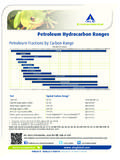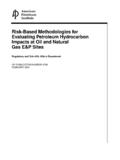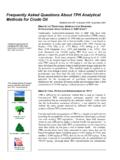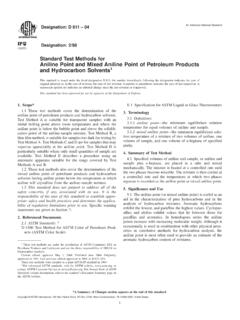Transcription of Rolling Revision of the WHO Guidelines for …
1 1 WHO/SDE/ Rolling Revision of the WHO Guidelines for Drinking-Water Quality Draft for review and comments (Not for citation) petroleum oils in drinking-water Background document for development of WHO Guidelines for Drinking-water Quality World Health Organization July 2004 2 General description Identity petroleum oils occur as complex mixtures of chemicals, primarily hydrocarbons. Hydrocarbons are organic compounds composed of carbon and hydrogen atoms arranged in varying structural configurations. At a simple level, they may be divided into two families: aliphatics and aromatics. The aliphatics may be further subdivided into four groups: alkanes (straight and branched chain), alkenes, alkynes and cyclic alkanes.
2 Alkynes are not generally found in petroleum oils and therefore will not be considered further. Within each hydrocarbon structural family and subfamily, there are homologous series. Each member of the series differs from adjacent members of the series by a repeating unit, such as a CH2 group. Contaminants such as polycyclic aromatic hydrocarbons (PAHs) may also be found in petroleum oils. petroleum oils undergo fractionation in order to produce oils for particular uses. Their composition varies according to the type of use and depends on their source and fraction. There are, therefore, significant differences between petroleum oils such as gasoline, diesel oil, aviation fuel and heating oil.
3 petroleum oil and fuel mixtures are produced from crude oil through a variety of blending and refining processes. Crude oil is distilled, and a variety of petroleum product fractions result, with distinct boiling point ranges. The chemical composition of all these products depends on the sources of crude oil or refinery streams from which they are produced (CONCAWE, 1985; IARC, 1989; ASTM, 1995). petroleum oils will often also contain additives, but these are normally present in very low concentrations. The exception is the oxygenates such as methyl tertiary butyl ether (MTBE), for which a different analytical method will be required. Physicochemical properties Within each homologous series of hydrocarbons, the physical properties of compounds change with the number of carbon atoms.
4 For example, there is an increase in boiling point of approximately 20 C for each carbon atom added to an n-alkane chain. The polarity of hydrocarbon structures governs the degree to which molecules interact with themselves and with water. Aromatic hydrocarbons are generally more polar than aliphatic hydrocarbons and therefore tend to be more soluble in water and less volatile than aliphatic hydrocarbons with a corresponding number of carbon atoms. Aromatic compounds above C20 are neither volatile nor soluble in water, whereas aliphatic C5 C6 and C7 C8 fractions have relatively high volatility and low solubility in water. Detailed physical and chemical properties are available for only about 250 petroleum hydrocarbons (TPHCWG, 1997a).
5 Organoleptic properties A number of the more soluble aromatic components, particularly the alkyl benzenes, have extremely low taste and odour thresholds in water and can render drinking-water unacceptable to consumers at relatively low levels of contamination. Several such components have been considered separately in the Guidelines : benzene, toluene, ethylbenzene, and xylene. Major uses 3 petroleum oils are widely used in large quantities as fuels for a wide range of purposes. petroleum oils undergo fractionation to produce, for example, gasoline, diesel oil, aviation fuel and heating oil. Environmental fate The differing chemical and physical properties of petroleum hydrocarbons mean that they will behave differently in the environment.
6 Persistence of petroleum hydrocarbon compounds in the environment is reflected by physical properties such as volatility, so that generally the persistence increases as the boiling point increases. The main processes affecting environmental concentrations are volatilization, biodegradation and dissolution in water; in the case of large spills to water or land, photodegradation may become a significant process. petroleum oils are stored and handled in a range of circumstances, and the primary concern for drinking-water is the potential for spills into source water or penetration of distribution systems or even treatment works. In the event of water contamination by petroleum products, the actual nature of the contaminants present will largely be a function of their solubility in water.
7 In general, the lower molecular weight aromatic compounds are the most water-soluble components. Analytical methods The methods for petroleum hydrocarbons are largely based on gas chromatography and liquid chromatography (TPHCWG, 1998a). These are relatively advanced analytical techniques and are not always readily available in many countries. The use of infrared spectrometry for total hydrocarbons may be of value in conjunction with analytical data on specific substances such as benzene and the low molecular weight aromatic hydrocarbons. Taste and odour testing would also be a valuable adjunct to chemical analysis. Environmental levels and human exposure Spills and leaks of petroleum oils are relatively common.
8 This is not surprising in view of their extensive storage, transportation and use. Exposure to the components of petroleum oils through drinking-water can be of short- or long-term duration. However, exposure is frequently the result of an accidental spill or short-term incident, in which the main issue for drinking-water is short-term exposure. Such incidents may lead to high concentrations of total petroleum hydrocarbons (TPH), in which case the probability of unacceptable taste and odour being detected by consumers will be significantly increased. Although the term TPH is widely used, it is rarely well defined. In essence, TPH is defined by the analytical method in other words, estimates of TPH concentration often vary depending on the analytical method used to measure it.
9 No single method measures the entire range of petroleum -derived hydrocarbons, since these measurements can include hundreds to thousands of individual compounds. It is not practical to analyse for all possible petroleum hydrocarbons in water, since it would be prohibitively costly to quantify each individual compound using current analytical technology. Because specific data are unavailable for many of the individual components of petroleum hydrocarbons, fractions were characterized from the available data in the literature by the Total petroleum Hydrocarbons Criteria Working Group (TPHCWG, 1998a). This Working Group based its fractions on physicochemical properties and also on data from partitioning models.
10 It was important that when delineating the fractions, the fractions were consistent with available analytical techniques. Hydrocarbon mixtures separate and partition based on these properties. There will be differences in both mobility and the level of adsorption, resulting in separation of the mixture. However, it was considered reasonable to 4assume that chemicals of a similar nature ( , aliphatic or aromatic) and boiling point would behave similarly. The TPHCWG specified the delineation of the different fractions on the basis on an order-of-magnitude differentiation in these simple partitioning properties (TPHCWG, 1997a). Toxicity In general terms, alkanes have relatively low toxicity, but those with five or more carbons have strong narcotic properties, particularly following inhalation exposure to high concentrations, and exposure to high concentrations of n-hexane may lead to irreversible effects on the nervous system.













